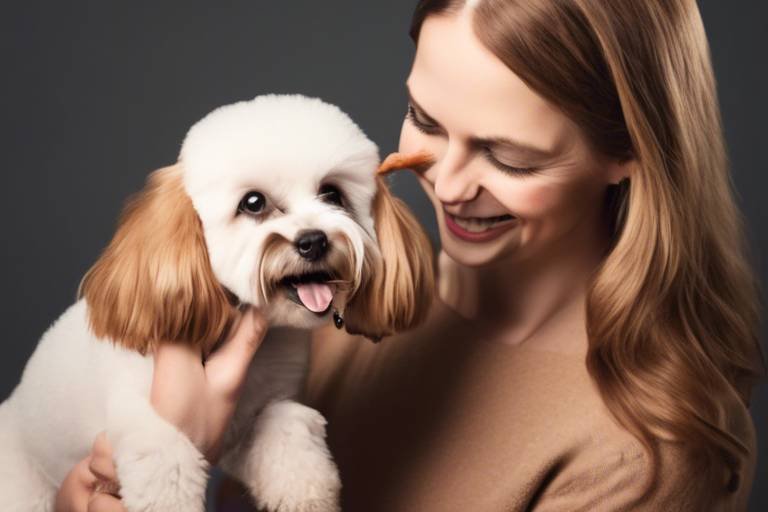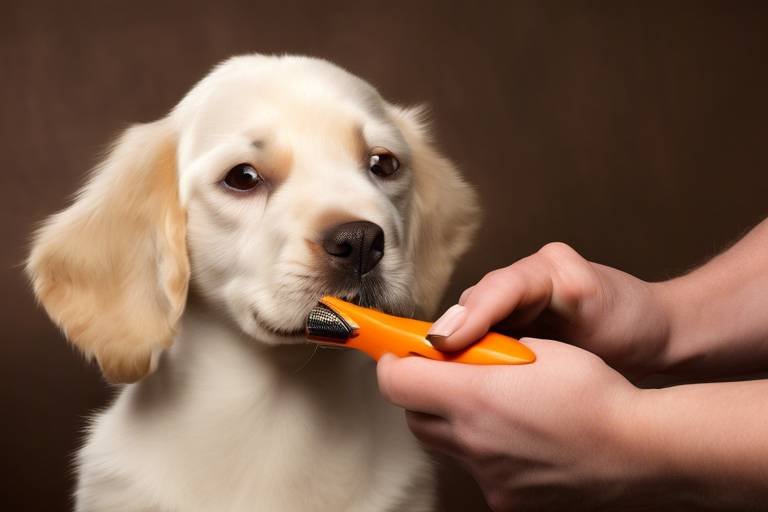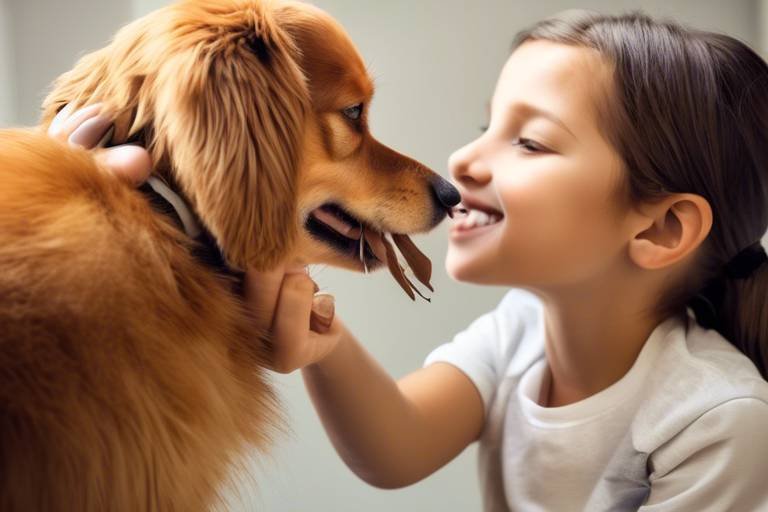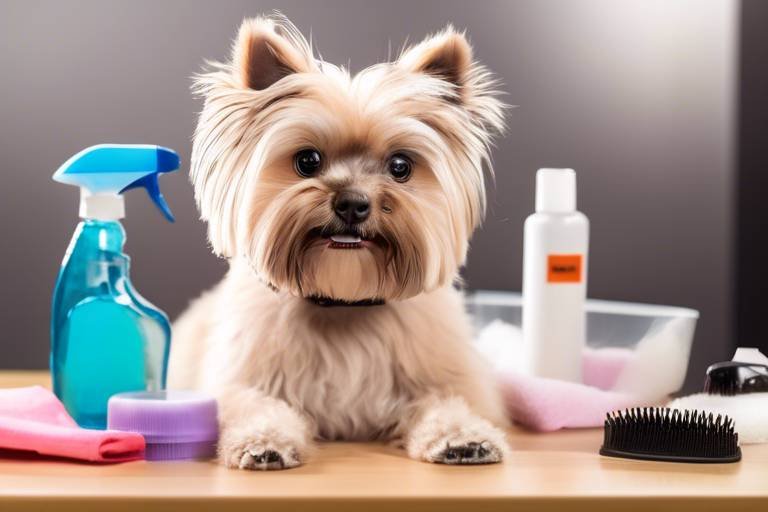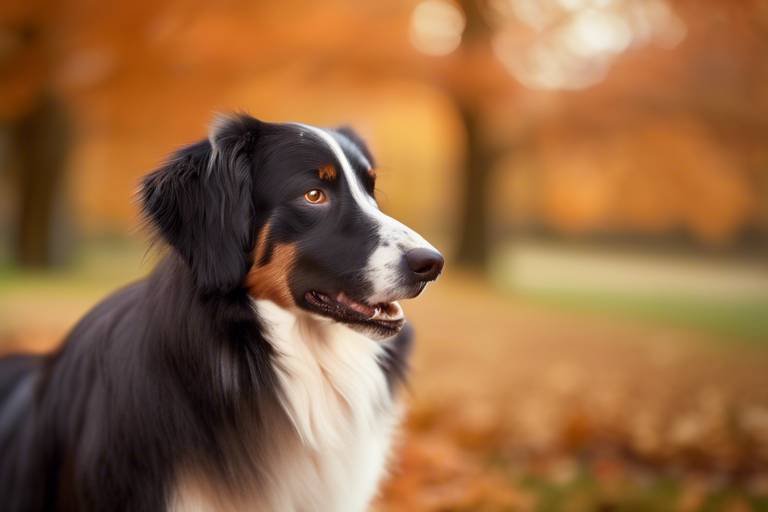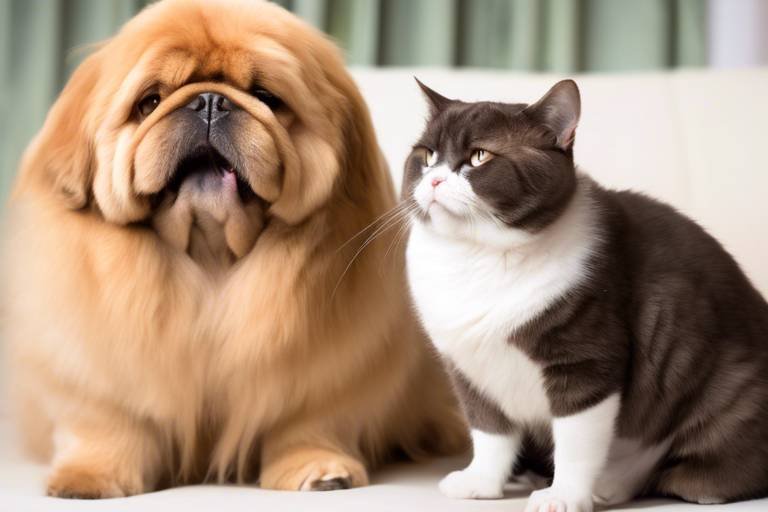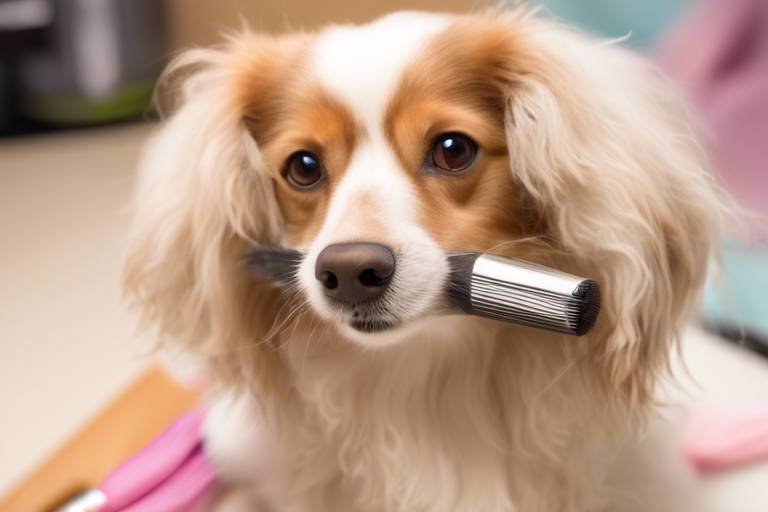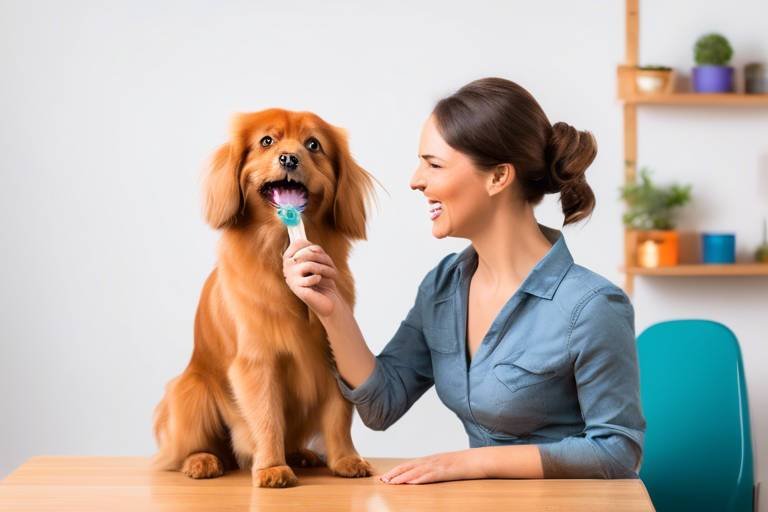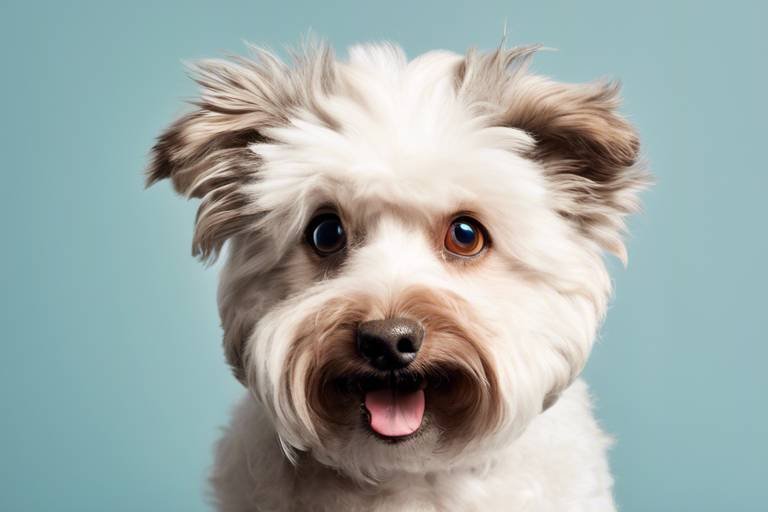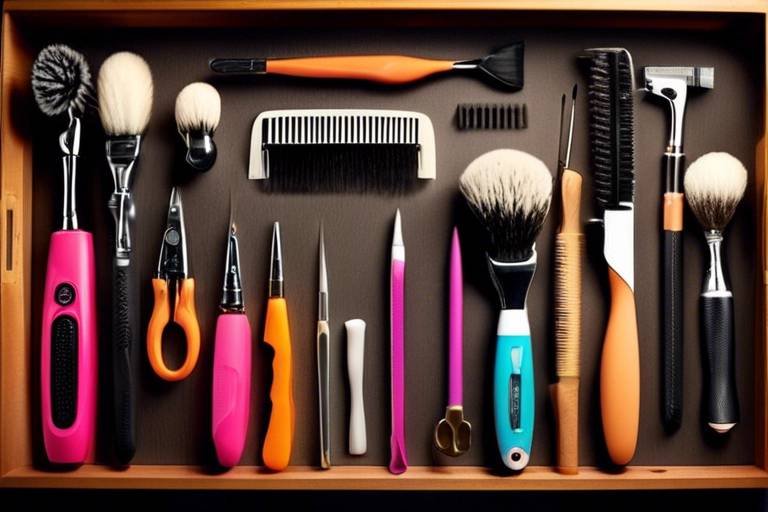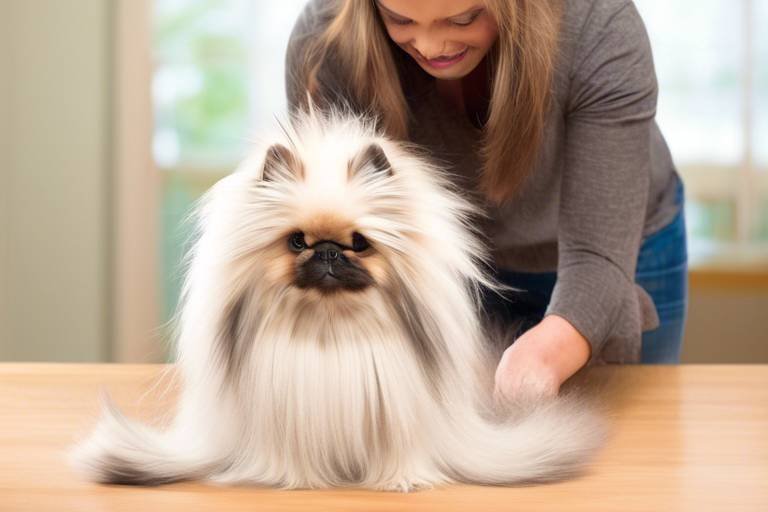How to Use Grooming to Enhance Bonding with Your Pet
Have you ever noticed how a simple grooming session can transform your relationship with your furry friend? It’s not just about keeping their coat shiny and clean; grooming serves as a powerful tool to deepen the bond you share. Imagine this: as you brush through your pet's fur, you’re not only removing tangles and dirt but also creating moments of connection, trust, and love. This article explores the profound connection between grooming and pet bonding, offering insights into techniques that foster trust, comfort, and joy for both pets and their owners.
Grooming is not just about aesthetics; it plays a crucial role in maintaining your pet's health and well-being. Regular grooming helps to identify skin issues, parasites, or other health concerns before they escalate. Additionally, it stimulates circulation and helps distribute natural oils throughout the coat, keeping it healthy and lustrous. Understanding its significance can strengthen your bond with your furry friend. Think of grooming as a ritual that not only benefits your pet's physical health but also enhances your emotional connection. When you take the time to groom your pet, it shows them that you care, which in turn fosters trust and affection.
Selecting appropriate grooming tools is essential for effective grooming sessions. The right brushes, combs, and clippers can make the process enjoyable and comfortable for your pet. Imagine trying to paint a masterpiece without the right brushes; the same applies to grooming. Using tools designed for your pet’s specific coat type can make all the difference in their comfort level and the overall success of the grooming session.
Different pets require different grooming tools. Familiarizing yourself with the types available can help you choose the best options for your pet's specific needs. Here’s a quick rundown of some essential grooming tools:
- Brushes: Great for removing loose fur and preventing mats.
- Combs: Ideal for detangling and smoothing the coat.
- Clippers: Perfect for trimming and maintaining coat length.
- Scissors: Useful for precise cutting and shaping.
Understanding the various brushes and combs can enhance your grooming experience. Each type serves a unique purpose, catering to different coat types and lengths. For instance, slicker brushes are fantastic for removing mats and tangles in long-haired breeds, while bristle brushes work wonders for short-haired pets, giving them a shiny finish. It's like having the right tool in your toolbox; it makes the job easier and more effective.
Using clippers and trimmers can be intimidating, especially if you're new to grooming. Knowing how to use these tools properly can ensure a stress-free grooming session for both you and your pet. Always start with a quiet clipper to prevent startling your furry friend. Additionally, make sure to introduce the clippers gradually, allowing your pet to get used to the sound and sensation before diving into the grooming process.
Adopting the right grooming techniques can make a significant difference in your pet's comfort and enjoyment. Learning these methods is key to successful grooming. For instance, always brush in the direction of hair growth to avoid discomfort, and take breaks if your pet seems anxious. Think of grooming as a dance; it requires patience, rhythm, and a little bit of practice to perfect.
A calm and inviting space is essential for grooming. Setting the right atmosphere can help alleviate stress for your pet and enhance the bonding experience. Consider using soft lighting, calming music, and a comfortable surface for your pet to sit on. This environment can transform grooming from a chore into a delightful bonding experience.
Identifying a quiet and comfortable location for grooming can make a world of difference. This choice can help your pet feel safe and relaxed during the process. Whether it's a cozy corner in your living room or a spot in the yard, make sure it’s free from distractions. Just like humans, pets thrive in serene environments!
Incorporating positive reinforcement techniques during grooming can build trust. Rewarding your pet with treats and praise can create a more enjoyable experience for both of you. Imagine how much more fun it is to do something when you know there’s a reward at the end! This approach not only makes grooming sessions more pleasant but also helps your pet associate grooming with positive feelings.
Regular grooming routines can strengthen the bond between you and your pet. Consistency helps your pet feel secure and familiar with the grooming process. Just like brushing your teeth becomes second nature, grooming can become a cherished part of your daily or weekly routine. It’s a time to connect, care, and show love.
Determining how often to groom your pet depends on their breed and coat type. Understanding these needs can help you establish a suitable routine. For example, long-haired breeds might require weekly grooming, while short-haired pets may only need it every few weeks. Tailoring your grooming schedule to your pet’s unique needs will ensure they remain comfortable and happy.
Integrating playtime into grooming sessions can make the experience more enjoyable. This approach can help your pet associate grooming with fun and positive interactions. Consider using toys or engaging in a little play before or after grooming. It’s like icing on the cake; it makes the entire experience sweeter!
Q: How often should I groom my pet?
A: The frequency of grooming depends on your pet's breed and coat type. Long-haired pets often need more frequent grooming compared to short-haired breeds.
Q: What should I do if my pet is anxious during grooming?
A: Create a calm environment, use gentle techniques, and incorporate positive reinforcement to help ease their anxiety.
Q: Can I groom my pet at home?
A: Absolutely! With the right tools and techniques, you can easily groom your pet at home while enhancing your bond.

The Importance of Grooming
Grooming is often perceived as merely a cosmetic endeavor, a way to keep our pets looking their best. However, it transcends aesthetics and dives deep into the realm of health and emotional well-being. Just like how we feel refreshed and revitalized after a good shower, our furry companions experience similar benefits from regular grooming. It's not just about brushing away loose fur; it’s about creating a routine that fosters trust and comfort between you and your pet.
When you groom your pet, you are actively participating in their health maintenance. Regular grooming helps to:
- Reduce Shedding: Regular brushing can significantly decrease the amount of fur that ends up on your furniture and clothes.
- Prevent Skin Issues: Grooming helps to remove dirt, debris, and dead skin cells, which can prevent skin irritations and infections.
- Detect Health Problems: During grooming sessions, you can check for unusual lumps, bumps, or skin conditions that may require veterinary attention.
- Improve Circulation: The act of brushing stimulates blood flow, which is beneficial for your pet's overall health.
Moreover, grooming is an excellent opportunity for you to bond with your pet. Imagine the joy of your dog wagging its tail or your cat purring contentedly as you brush their coat. These moments are not just about keeping them clean; they are about building a connection that solidifies your role as a caregiver and friend. Pets thrive on routine, and incorporating grooming into your schedule can provide them with a sense of security and familiarity.
Understanding the importance of grooming goes beyond the physical benefits; it is a pathway to emotional enrichment. Engaging in this activity allows you to read your pet's body language, understand their moods, and respond to their needs. This two-way communication fosters a deeper relationship. So, the next time you pick up that brush or clipper, remember that you are not just grooming; you are enhancing the bond that makes your relationship with your pet truly special.

Choosing the Right Grooming Tools
When it comes to grooming your beloved pet, choosing the right tools can make all the difference. Imagine trying to paint a masterpiece with the wrong brush; it just wouldn’t work! Similarly, using the right grooming tools not only enhances the experience for both you and your pet but also ensures that the grooming process is effective and enjoyable. Whether your furry friend has a long, flowing coat or a short, sleek fur, there are specific tools designed to cater to their unique needs.
First and foremost, it’s essential to understand that different pets require different grooming tools. For instance, a golden retriever has a vastly different coat compared to a bulldog. Therefore, familiarizing yourself with the various types of grooming tools available can help you choose the best options for your pet. Here’s a quick breakdown of some of the most common grooming tools:
| Tool Type | Best For | Purpose |
|---|---|---|
| Brushes | Long-haired breeds | Detangling and removing loose fur |
| Combs | All breeds | Smoothing out fur and removing debris |
| Clippers | Short-haired breeds | Trimming and shaping fur |
| Shears | All breeds | Precision cutting and shaping |
| De-shedding tools | Heavy shedders | Reducing shedding and keeping the coat healthy |
Understanding the purpose of each tool is crucial. For example, brushes are fantastic for detangling and removing loose fur, while combs can help smooth out the fur and remove any debris that may be tangled in. If your pet has a thick or curly coat, investing in a good de-shedding tool can be a game changer, especially during shedding season.
Now, let’s talk about the intimidating duo: clippers and trimmers. Many pet owners shy away from using these tools due to fear of hurting their pets or making a mess. However, with the right knowledge and practice, clippers can become your best friend. It’s all about choosing the right size and type of clipper blade based on your pet’s coat type. For instance, shorter blades are suitable for thick fur, while longer ones work better for finer coats.
Before you dive into grooming, take a moment to assess your pet’s needs. This not only includes their coat type but also their temperament. Some pets may be more sensitive to grooming than others, which may require softer tools or a gentler approach. By selecting the right grooming tools, you’re not just enhancing your pet's appearance; you’re also contributing to their overall well-being and comfort.
In summary, the right grooming tools can transform a routine chore into a bonding experience. So, take your time, do your research, and invest in quality tools that will make grooming a joy for both you and your furry companion. Remember, a well-groomed pet is a happy pet, and happy pets lead to even happier pet owners!
Types of Grooming Tools
When it comes to grooming your beloved pet, understanding the available is crucial. Just like a painter needs the right brushes to create a masterpiece, you need the right tools to ensure your pet looks and feels their best. Each tool serves a unique purpose and is designed to cater to different coat types, lengths, and even temperaments. So, let's dive into the world of grooming tools and see what options are out there!
First off, we have brushes and combs. These are the staples of any grooming kit. Brushes come in various shapes and sizes, each tailored for specific coat types. For instance, a slicker brush is fantastic for removing tangles and mats from long-haired breeds, while a bristle brush is perfect for short-haired pets, helping to distribute natural oils and keep their coat shiny. Combs, on the other hand, are excellent for precision work. They can help you tackle those stubborn knots and ensure every inch of your pet's coat is well-groomed.
Next, let’s talk about clippers and trimmers. These tools might seem intimidating at first, but they can be your best friends when it comes to keeping your pet’s coat in tip-top shape. Clippers are ideal for larger areas and can quickly trim down thick fur, while trimmers are perfect for more delicate areas, like around the eyes, paws, and ears. It's essential to choose clippers that are quiet and have adjustable blades to accommodate different coat lengths, as this can make the experience less stressful for your furry friend.
Here’s a quick overview of some common grooming tools:
| Tool Type | Purpose | Best For |
|---|---|---|
| Brush | Removing tangles and distributing oils | Long-haired and short-haired pets |
| Comb | Detailing and precision grooming | All coat types |
| Clipper | Trimming large areas quickly | Thick or long coats |
| Trimmer | Detailing and finishing touches | Delicate areas on all pets |
By understanding the different types of grooming tools, you can tailor your grooming sessions to meet your pet's specific needs. Each tool not only helps in maintaining your pet's appearance but also plays a significant role in their overall health. Regular brushing can prevent skin issues, while proper trimming can keep your pet comfortable during warm weather. So, invest some time in selecting the right tools, and you'll be well on your way to making grooming a positive experience for both you and your furry companion!
- How often should I groom my pet? - The frequency of grooming depends on your pet's breed and coat type. Long-haired breeds may require grooming several times a week, while short-haired pets may need it less frequently.
- What if my pet doesn't like being groomed? - Patience is key! Start slow, use positive reinforcement, and make the experience enjoyable with treats and praise.
- Can I use human grooming tools on my pet? - It's best to use tools specifically designed for pets, as human tools may not be safe or effective for their unique needs.
Brushes and Combs
When it comes to grooming your beloved pet, choosing the right can make all the difference in the world. Just like how different hair types require specific brushes for humans, pets have their own unique grooming needs based on their coat type and length. Understanding the various options available is essential for ensuring a comfortable and enjoyable grooming experience for your furry friend.
For instance, if your pet has a long coat, a slicker brush is a fantastic tool to remove tangles and mats effectively. The fine, bent wires on a slicker brush can reach deep into the undercoat without causing discomfort. On the other hand, if your pet has a short coat, a bristle brush might be more suitable. It helps in distributing natural oils throughout the coat, giving it a healthy shine while removing loose fur.
Additionally, combs serve a different purpose. They are perfect for detangling and smoothing out the fur after brushing. A wide-toothed comb is particularly useful for pets with thicker fur, as it can gently work through knots without pulling or causing pain. For pets with finer hair, a narrow-toothed comb can help to remove any small tangles and ensure a sleek finish.
It's also worth noting that some pets may have sensitive skin. In such cases, opting for a rubber brush can be a game-changer. These brushes are gentle and can be used during bath time to massage the skin while washing away dirt and loose hair. This not only makes grooming a pleasant experience but also promotes bonding as your pet enjoys the gentle touch.
To summarize, the right grooming tools can transform a mundane chore into a delightful bonding experience. Here’s a quick reference table to help you choose the right brush or comb for your pet:
| Coat Type | Recommended Brush/Comb | Purpose |
|---|---|---|
| Long Coat | Slicker Brush | Removes tangles and mats |
| Short Coat | Bristle Brush | Distributes oils and removes loose fur |
| Thick Fur | Wide-Toothed Comb | Detangles without pulling |
| Fine Hair | Narrow-Toothed Comb | Removes small tangles |
| Sensitive Skin | Rubber Brush | Gentle massage during grooming |
In conclusion, investing time in understanding the different brushes and combs available can significantly enhance your grooming sessions. Not only will this ensure your pet looks their best, but it will also strengthen the bond you share as you engage in this nurturing activity together.
- How often should I groom my pet? - It depends on the breed and coat type, but regular grooming is beneficial for all pets.
- Can I use human brushes on my pet? - It's best to use brushes specifically designed for pets to avoid damaging their coat.
- What should I do if my pet dislikes grooming? - Start slowly, use positive reinforcement, and create a comfortable environment to help them adjust.
Clippers and Trimmers
When it comes to grooming your pet, clippers and trimmers can be your best friends, or they can feel like a daunting challenge. The key is to understand how to use these tools effectively to ensure a stress-free experience for both you and your furry companion. First off, it's important to choose the right type of clipper or trimmer based on your pet's breed and coat type. For instance, long-haired breeds may require a more powerful clipper, while short-haired breeds might need something lighter and more precise.
Before you even turn on the clippers, take a moment to familiarize your pet with the sound and feel of the tool. You can achieve this by letting them sniff the clippers while they are off. Gradually introduce the sound by turning them on at a distance, rewarding your pet with treats and praise to create positive associations. Remember, patience is key! If your pet seems anxious, take a break and try again later. This process can transform what might seem like a scary ordeal into a bonding experience.
When you’re ready to start grooming, ensure that your pet is in a comfortable position. A non-slip grooming mat can help keep your pet steady, especially if they are a bit wiggly. Always start with the areas your pet is most comfortable with, such as the back or sides, before moving to more sensitive areas like the face or paws. Using the right technique is crucial; hold the clippers flat against the skin and move in the direction of hair growth to avoid any discomfort.
There are various types of clippers available, each designed for specific grooming tasks. Here’s a quick overview:
| Type of Clipper | Best For |
|---|---|
| Rotary Clippers | Thick or long coats |
| Vibrating Clippers | Fine or short coats |
| Cordless Clippers | Convenience and mobility |
After grooming, always check your pet for any signs of discomfort. If they seem uneasy, it might be a sign that you need to adjust your approach or take a break. Regular grooming with clippers and trimmers not only keeps your pet looking sharp but also strengthens the bond between you two. The more comfortable your pet is with the grooming process, the more enjoyable it will be for both of you!
- How often should I groom my pet? – It depends on the breed and coat type. Long-haired pets may need grooming every few weeks, while short-haired ones may only need it once a month.
- Are clippers safe for my pet? – Yes, when used properly. Ensure you choose the right clipper for your pet's coat type and always be gentle.
- What should I do if my pet is scared of clippers? – Introduce the clippers slowly, use treats, and create a positive environment to help alleviate their fears.
Grooming Techniques
When it comes to grooming your pet, the technique you use can make all the difference between a pleasant experience and a stressful one. Think of grooming as a dance; it requires rhythm, patience, and a bit of practice. The right grooming techniques not only keep your pet looking fabulous but also ensure they feel comfortable and relaxed throughout the process. So, how can you master this art? Let’s dive into some essential techniques that will enhance your grooming sessions.
First and foremost, always start with a gentle approach. Just like humans, pets have their own comfort zones. Begin by letting your furry friend sniff the grooming tools before using them. This simple act can ease their anxiety and make them more receptive to the grooming process. Once your pet is comfortable, you can move on to brushing. Remember, the key here is to brush in the direction of hair growth. This not only prevents discomfort but also helps in removing loose fur and dirt effectively.
Another important technique is to section the coat. For longer-haired pets, dividing their coat into manageable sections can make the grooming process smoother and less overwhelming. Use a clip or your fingers to separate the fur, and focus on one section at a time. This method allows you to give your pet the attention they deserve and ensures that no tangles are left behind. If you encounter any knots, use a detangling spray or a bit of conditioner to ease them out gently. It’s crucial to be patient and avoid pulling, as this can lead to discomfort.
Next up is bathing, which is often a part of grooming. It’s essential to use a pet-friendly shampoo that suits your pet’s skin type. Always test the water temperature to ensure it’s lukewarm; too hot or too cold can be uncomfortable. While bathing, use a soft sponge or your hands to massage the shampoo into their coat. This not only cleans but also provides a soothing experience that can strengthen your bond. After rinsing thoroughly, don’t forget to dry your pet properly. A towel or a pet dryer can help, but be cautious with the dryer to avoid startling your pet.
Finally, nail trimming is a crucial yet often dreaded part of grooming. To ease this process, consider using a quiet nail clipper or a grinder. Start by letting your pet get used to the sound and feel of the tool. When you’re ready to trim, hold their paw gently but firmly, and clip just the tip of the nail. If you’re unsure, it’s wise to consult a professional or watch instructional videos to avoid cutting too close to the quick, which can be painful.
Incorporating these techniques into your grooming routine will not only keep your pet looking their best but will also make the experience enjoyable for both of you. Remember, grooming is a bonding activity, and the more relaxed and happy your pet feels, the stronger your connection will become.
Q: How often should I groom my pet?
A: The frequency of grooming depends on your pet's breed and coat type. Generally, long-haired pets require more frequent grooming than short-haired ones. Aim for at least once a week for regular maintenance.
Q: What if my pet is afraid of grooming?
A: Start slowly and use positive reinforcement. Allow them to familiarize themselves with the tools and gradually introduce grooming sessions. Reward them with treats and praise to create a positive association.
Q: Can I groom my pet at home?
A: Absolutely! With the right tools and techniques, home grooming can be a rewarding experience. However, if you're unsure about any part of the process, don’t hesitate to consult a professional groomer.

Creating a Comfortable Grooming Environment
When it comes to grooming your pet, the environment you create can make all the difference. Imagine trying to relax in a noisy, chaotic space—it's nearly impossible, right? Your furry friend feels the same way! A calm and inviting atmosphere is essential for a successful grooming session. By setting the right tone, you not only reduce stress but also enhance the bonding experience between you and your pet.
First and foremost, choosing the right location for grooming is crucial. Ideally, this should be a quiet area in your home where your pet feels safe and comfortable. Think of it as creating a little sanctuary just for them. This could be a cozy corner of your living room or a quiet spot in the backyard. The key is to keep distractions to a minimum. If possible, close windows to block out outside noises and turn off any loud appliances that might startle your pet.
Next, consider the temperature of the space. Pets can be sensitive to heat and cold, so make sure the area is at a comfortable temperature. You wouldn't want your pet to feel too hot or chilly during grooming, as this could lead to anxiety and discomfort. A gentle breeze from a fan or a warm blanket can help create a cozy environment that puts your pet at ease.
Another important aspect is the grooming surface. Whether you’re using a grooming table or simply a soft blanket on the floor, make sure it’s stable and comfortable for your pet. A non-slip surface can prevent accidents and help your pet feel secure. You might even want to place their favorite blanket or toy nearby to create a sense of familiarity.
Finally, don’t underestimate the power of calming scents. Just like humans, pets can respond positively to soothing aromas. Consider using pet-safe essential oils or calming sprays designed for animals. Scents like lavender or chamomile can help create a peaceful atmosphere. Just be sure to use these products sparingly and ensure they are safe for your specific type of pet.
In summary, creating a comfortable grooming environment is all about making your pet feel safe and relaxed. By choosing the right location, maintaining a pleasant temperature, providing a stable surface, and incorporating calming scents, you can transform grooming from a chore into a delightful bonding experience. Your pet will not only look great after a grooming session but will also feel loved and cared for.
- How often should I groom my pet? The frequency of grooming depends on your pet's breed and coat type. Long-haired breeds may require more frequent grooming than short-haired ones.
- What tools do I need for grooming? Essential tools include brushes, combs, clippers, and nail trimmers. The specific tools will depend on your pet's coat type.
- Can I groom my pet at home? Absolutely! With the right tools and techniques, you can groom your pet at home. Just ensure you create a calm environment to make the experience enjoyable for both of you.
- What if my pet doesn't like grooming? If your pet seems anxious, try to introduce grooming gradually. Use positive reinforcement, like treats and praise, to help them associate grooming with positive experiences.
Choosing the Right Location
When it comes to grooming your pet, the location you choose can make a world of difference. Imagine trying to relax in a noisy, chaotic environment; it would be nearly impossible, right? The same goes for your furry friend! Selecting a calm and quiet space for grooming is essential to help them feel safe and at ease. Ideally, you want a spot that is free from distractions, where both you and your pet can focus on the task at hand.
Consider setting up your grooming station in a familiar area of your home, such as a cozy corner in the living room or a designated space in the bathroom. This familiarity can help your pet feel more comfortable. Additionally, make sure that the space is well-lit, so you can see what you’re doing without straining your eyes. A well-lit area also allows you to spot any potential issues with your pet's coat or skin that may need attention.
Moreover, think about the temperature of the environment. You wouldn’t want to groom your pet in a cold or overly hot room. Keeping the space comfortably warm can help your pet relax, making the grooming process smoother. If you’re grooming a long-haired breed, you might want to consider using a fan to help blow away loose fur, but ensure it’s not too strong, as it could stress your pet out.
Lastly, think about the surface you’re using for grooming. A non-slip mat or a comfortable blanket can provide both stability and comfort for your pet. This way, they won’t feel anxious about slipping or sliding around during the grooming session. Just like we prefer to stand on solid ground, our pets appreciate a safe space too!
In summary, choosing the right location for grooming involves considering noise levels, lighting, temperature, and the surface you’ll work on. By creating a peaceful and inviting atmosphere, you’ll not only make grooming easier but also strengthen the bond between you and your pet. After all, a happy pet makes for a happy grooming experience!
- How often should I groom my pet? The frequency of grooming depends on your pet's breed and coat type. Long-haired breeds may require grooming several times a week, while short-haired breeds might only need it once a month.
- What if my pet doesn't like grooming? If your pet seems anxious, try to create a more positive experience by using treats and praise. Gradually introduce them to grooming tools and techniques to help them feel more comfortable.
- Can I groom my pet at home? Absolutely! With the right tools and techniques, you can successfully groom your pet at home. Just make sure to choose a quiet location and take your time to ensure a stress-free experience.
Using Positive Reinforcement
When it comes to grooming your pet, positive reinforcement can be a game changer. Imagine this: you’re brushing your dog, and instead of feeling anxious or restless, they’re wagging their tail and enjoying the moment. This transformation doesn’t just happen by chance; it’s the result of creating a trusting environment where your pet feels safe and appreciated. By rewarding your furry friend during grooming sessions, you can foster a stronger bond that enhances the overall experience for both of you.
So, how do you incorporate positive reinforcement into your grooming routine? First, it’s essential to understand what motivates your pet. For some, it might be treats, while for others, it could be verbal praise or a favorite toy. The key is to use these motivators effectively. For instance, every time you gently brush a sensitive area or complete a grooming task, offer a small treat or a hearty “good boy/girl!” This simple act can make a world of difference.
Here are some tips to effectively use positive reinforcement during grooming:
- Start Small: If your pet is new to grooming, begin with short sessions. Gradually increase the duration as they become more comfortable.
- Be Consistent: Use the same cues and rewards each time you groom. This consistency helps your pet understand what to expect.
- Celebrate Progress: Whether it’s a full grooming session or just a few brushes, celebrate every achievement with praise and treats.
Moreover, it’s crucial to remain patient and observant. If your pet shows signs of stress or discomfort, take a step back. Perhaps they need a break or a little more reassurance. By tuning into their emotions, you can adjust your approach and continue to build trust. Remember, grooming should be a positive experience, not a chore. When your pet associates grooming with treats and affection, you’ll find that they not only tolerate it but may even look forward to it!
In summary, using positive reinforcement during grooming can significantly enhance your bond with your pet. It transforms grooming from a potentially stressful task into a joyful experience filled with love and trust. So, the next time you gather your grooming tools, remember to bring along some treats and a lot of encouragement. Your furry friend will thank you for it!
Q: How can I tell if my pet is stressed during grooming?
A: Signs of stress can include panting, whining, trying to escape, or excessive licking. If you notice these behaviors, take a break and comfort your pet.
Q: What types of treats are best for positive reinforcement?
A: Small, soft treats that are easy to chew are ideal. Choose something your pet loves to keep them motivated.
Q: How often should I groom my pet?
A: The frequency of grooming depends on your pet’s breed and coat type. Long-haired breeds may require weekly grooming, while short-haired breeds might only need it monthly.
Q: Can I use toys as rewards during grooming?
A: Absolutely! If your pet loves a particular toy, using it as a reward can be very effective. Just ensure it’s safe and appropriate for the grooming environment.

Establishing a Grooming Routine
Establishing a consistent grooming routine is one of the best ways to enhance the bond you share with your pet. Just like humans benefit from regular self-care, pets also thrive on routine. It creates a sense of predictability and security, allowing them to feel comfortable and relaxed during grooming sessions. Imagine how you feel when you have a set schedule—there's comfort in knowing what to expect! This is exactly how your furry friend will feel when grooming becomes a regular part of their life.
When it comes to how often you should groom your pet, it really depends on their breed, coat type, and individual needs. For instance, long-haired breeds may require grooming several times a week to prevent mats and tangles, while short-haired breeds might only need a weekly brush. To simplify this, here’s a quick reference table:
| Breed Type | Coat Type | Recommended Grooming Frequency |
|---|---|---|
| Long-haired | Wavy or Curly | 3-4 times a week |
| Medium-haired | Straight | 1-2 times a week |
| Short-haired | Smooth | Once a week |
| Hairless | N/A | As needed (skin care) |
In addition to frequency, integrating playtime into your grooming routine can significantly enhance the experience for both you and your pet. Think of it as a two-for-one deal: you're keeping your pet's coat healthy while also having fun! For example, you might start with a few minutes of brushing, followed by a quick game of fetch or tug-of-war. This not only keeps your pet engaged but also helps them associate grooming with positive experiences. After all, who doesn’t love a good game?
Remember, consistency is key. The more regularly you groom your pet, the more accustomed they will become to the process. This familiarity will help reduce any anxiety or apprehension they might initially feel. So, whether it’s a quick brush after a walk or a more thorough grooming session on the weekend, try to stick to a schedule. Your pet will thank you for it, and you’ll find that your bond grows stronger with each session!
- How often should I groom my pet? It depends on the breed and coat type. Long-haired pets may need grooming several times a week, while short-haired ones might only need it weekly.
- What tools do I need for grooming? Basic tools include brushes, combs, and clippers. The specific tools will depend on your pet's coat type.
- How can I make grooming more enjoyable for my pet? Incorporate playtime and positive reinforcement, such as treats and praise, to create a fun atmosphere.
Frequency of Grooming Sessions
Determining how often to groom your pet can feel like a daunting task, but it's essential for their health and happiness. The frequency of grooming sessions largely depends on your pet's breed, coat type, and lifestyle. For instance, long-haired breeds like Persian cats or Golden Retrievers require more frequent grooming—typically every 4 to 6 weeks—to prevent matting and ensure their coats remain healthy. On the other hand, short-haired breeds like Beagles or Boxers may only need grooming every 8 to 12 weeks, as their coats are less prone to tangling.
It's also important to consider your pet's activity level and environment. If your furry friend enjoys outdoor adventures, they might pick up dirt, debris, or even pests that necessitate more frequent grooming. Additionally, pets that shed heavily may benefit from regular brushing sessions to minimize loose hair around your home. A good rule of thumb is to establish a grooming routine based on your pet's needs, which can be adjusted as you observe how they respond to grooming.
To help you better understand the grooming frequency for different types of pets, here's a quick reference table:
| Pet Type | Coat Length | Recommended Grooming Frequency |
|---|---|---|
| Dog | Long-haired | Every 4-6 weeks |
| Dog | Short-haired | Every 8-12 weeks |
| Cat | Long-haired | Every 4-6 weeks |
| Cat | Short-haired | Every 8-12 weeks |
In addition to breed and coat type, pay attention to your pet's behavior during grooming. If they seem anxious or uncomfortable, it might be a sign that you need to adjust the frequency or technique of your grooming sessions. Remember, the goal is to make grooming a positive experience that fosters trust and connection between you and your pet.
Ultimately, a consistent grooming routine not only keeps your pet looking their best but also strengthens your bond through shared experiences. So, grab those brushes and clippers, and make grooming a fun and integral part of your pet care routine!
- How often should I groom my dog? It depends on the breed and coat type. Long-haired dogs typically need more frequent grooming than short-haired ones.
- Can I groom my pet at home? Absolutely! With the right tools and techniques, you can create a comfortable grooming routine at home.
- What if my pet doesn't like grooming? Use positive reinforcement, like treats and praise, to help them associate grooming with positive experiences.
- Should I take my pet to a professional groomer? If you're unsure about grooming techniques or if your pet has specific needs, professional groomers can provide valuable assistance.
Incorporating Playtime
When it comes to grooming your pet, one of the most effective ways to make the experience enjoyable is by into the routine. Think of grooming as a dance—there's a rhythm to it, and when you blend in a bit of fun, it transforms from a chore into a delightful bonding experience. By adding playful elements, you not only keep your pet engaged but also help them associate grooming with positive feelings.
Start by choosing toys that your pet loves. Whether it's a squeaky toy, a feather wand, or a simple ball, having their favorite plaything nearby can do wonders. You might even consider taking short breaks during grooming sessions to toss a toy around or engage in a quick game of tug-of-war. This not only breaks the monotony but also allows your pet to release some energy, making them more relaxed when you return to grooming.
Another fun idea is to use grooming as an opportunity for some interactive play. For instance, while brushing your dog, you can pause occasionally to engage in a little fetch or hide-and-seek with a treat. This keeps their spirits high and reinforces the idea that grooming is a part of a fun activity rather than a tedious task. You can also use treats as a reward for good behavior during grooming, creating a positive feedback loop that encourages your pet to enjoy these sessions.
Additionally, consider the timing of your grooming sessions. If your pet is particularly energetic, try to schedule grooming right after a play session. This way, they might be more inclined to relax and enjoy the grooming process. On the flip side, if your pet is a bit sluggish, a short burst of play can help invigorate them, making them more receptive to grooming.
Remember, the goal is to create a nurturing environment where your pet feels safe and happy. By weaving in playtime with grooming, you strengthen your bond and make the entire experience a lot more enjoyable. After all, grooming is not just about keeping your pet looking good; it's about fostering a deeper connection that enhances both of your lives.
- How often should I groom my pet? The frequency of grooming largely depends on your pet's breed, coat type, and lifestyle. Long-haired breeds may require more frequent grooming, while short-haired pets might need less.
- What are the best tools for grooming? The best tools vary by pet, but generally, brushes, combs, and clippers designed specifically for your pet's coat type will yield the best results.
- Can I groom my pet at home? Absolutely! With the right tools and techniques, grooming at home can be a rewarding experience for both you and your pet.
- What if my pet doesn't like grooming? If your pet is anxious about grooming, try to introduce it gradually, incorporate playtime, and use treats to create positive associations.
Frequently Asked Questions
- Why is grooming important for my pet?
Grooming is essential not just for keeping your pet looking good, but it also plays a vital role in their overall health. Regular grooming helps to prevent matting, reduces shedding, and allows you to check for any skin issues or parasites. Plus, it’s a great way to bond with your furry friend!
- How do I choose the right grooming tools?
Selecting the right grooming tools depends on your pet’s breed, coat type, and personal preferences. For instance, long-haired pets may need a slicker brush, while short-haired ones might do well with a bristle brush. It’s worth doing a little research or asking your vet for recommendations to ensure you’re equipped for the job.
- What grooming techniques should I use?
Using gentle and calm techniques can make grooming a pleasant experience for your pet. Start by brushing in the direction of hair growth, and be sure to take breaks if your pet seems anxious. Incorporating positive reinforcement, like treats and praise, can also help your pet associate grooming with good vibes.
- How can I create a comfortable grooming environment?
To create a stress-free grooming environment, choose a quiet, well-lit area where your pet feels safe. You might want to lay down a soft blanket or mat to make it cozy. Remember, your calm demeanor will help your pet relax, so play some soothing music if that helps!
- How often should I groom my pet?
The frequency of grooming sessions largely depends on your pet's breed and coat type. For example, long-haired breeds may require grooming several times a week, while short-haired breeds might only need it once a month. Regular grooming not only keeps their coat healthy but also strengthens your bond.
- Can I incorporate playtime into grooming sessions?
Absolutely! Mixing playtime with grooming can make the experience much more enjoyable for your pet. Try to include short play breaks during grooming to keep things light and fun. This can help your pet associate grooming with positive experiences rather than just a chore.

